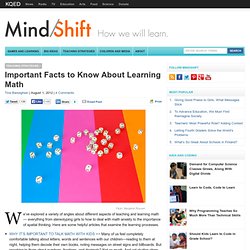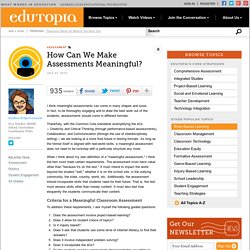

Important Facts to Know About Learning Math. Teaching Strategies Flickr: Benjamin Rossen We’ve explored a variety of angles about different aspects of teaching and learning math — everything from stereotyping girls to how to deal with math anxiety to the importance of spatial thinking.

Here are some helpful articles that examine the learning processes. WHY IT’S IMPORTANT TO TALK MATH WITH KIDS >> Many of us feel completely comfortable talking about letters, words and sentences with our children—reading to them at night, helping them decode their own books, noting messages on street signs and billboards. But speaking to them about numbers, fractions, and decimals? Explore: math, stereotypes. How Can We Make Assessments Meaningful? I think meaningful assessments can come in many shapes and sizes.

In fact, to be thoroughly engaging and to draw the best work out of the students, assessments should come in different formats. Thankfully, with the Common Core standards exemplifying the 4Cs -- Creativity and Critical Thinking (through performance-based assessments), Collaboration, and Communication (through the use of interdisciplinary writing) -- we are looking at a more fluid future in testing formats. As long as the format itself is aligned with real-world skills, a meaningful assessment does not need to be lockstep with a particular structure any more.
When I think about my own definition of a "meaningful assessment," I think the test must meet certain requirements. The assessment must have value other than "because it's on the test. " Criteria for a Meaningful Classroom Assessment To address these requirements, I ask myself the following guided questions: Does the assessment involve project-based learning?
Getting Started with Project-Based Learning (Hint: Don't Go Crazy) Before the start of the school year, many of us want to use the remaining weeks of summer to learn some new skills -- such as project-based learning (PBL).

One of the things we stress for new PBL practitioners is, as I say, "don't go crazy. " It's easy to go "too big" when you first start PBL. I have heard from many teachers new to PBL that a large, eight-week integrated project was a mistake. So how do you start PBL in ways that will ensure your success as a learner and teacher? Here are a few tips to consider. Start Small As I said, "Don't go crazy! " Plan Now One of the challenges of PBL, but also one of the joys, is the planning process. Limited Technology We love technology, but sometimes we get too "tech happy. " Know the Difference Between PBL and Projects This is the big one! We are all learners, and when we start something new, we start small. Photo credit: wwworks via Flickr (CC BY 2.0) Webinars. A collection of free virtual broadcasts, including upcoming and on-demand webinars.

Browse our premium webinars here. All webinars are accessible for a limited time after the original live streaming date. Participation certificates are not provided, but live viewers receive a post-event confirmation email. How to Effectively Use Technology for Classroom Instruction Content provided by Istation. This webinar takes place on Sept. 19, 2017 @ 2 p.m. ‘‘Technology’’ is a broad and often vague term in education. In this webinar, instructional leaders and district administrators will learn how to bridge the gap between wide-ranging research and classroom applications.
. • The levels of technology integration. • Common mistakes of technology integration. • The reasons teachers often don’t use research on technology to inform their practices. • How to facilitate teachers’ use of educational research and make it more accessible. • The latest research on the Istation integrated learning system. —Dr.